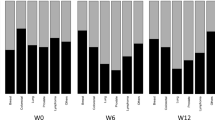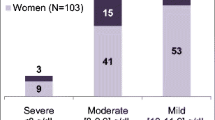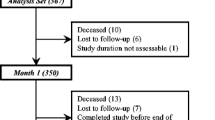Abstract
Background
Anemia is often associated with a lower quality of life and less tolerance to treatments in cancer patients.
Objective
The aims of this retrospective study were to assess the biological (hemoglobin, Hb) and clinical (ECOG index) impact of ferric carboxymaltose (FCM) and to identify predictive factors of response in cancer patients with iron deficiency.
Methods
We included 133 patients with solid tumors who received at least one dose of FCM in 2015.
Results
At baseline, most patients had metastatic cancer (70%), were undergoing chemotherapy (82%), suffered from anemia (90%), and 72% had an ECOG 0–1 index. Mean Hb level was statistically higher at M1 (108.3 g/L ± 13.9), M2 (110.3 g/L ± 16.1), and M3 (111.7 g/L ± 12.6) than M0 (99.2 g/L ± 13.9). Mean ECOG score increased significantly at M1 (1.31 ± 0.80) and M2 (1.31 ± 0.87) compared to M0 (1.13 ± 0.80). Variations of ECOG index between M0 and M1 were independent of levels of Hb and ferritin at inclusion and pretreatment use of transfusion and ESAs. Increase of Hb level was higher in patients with Hb < 100 g/L, ferritinemia < 800 ng/ml, or transfused before inclusion. In multivariate analysis, an ECOG index of 0 was the only predictive factor of an increase of ECOG index and Hb level < 100 g/L and ferritinemia < 800 ng/ml were predictive of an increase in Hb.
Conclusion
Even though there was no improvement in ECOG index, this study did identify an increase of Hb for patients receiving FCM, indicating its potential benefit in iron-deficient cancer patients.


Similar content being viewed by others
References
Ludwig H, Van Belle S, Barrett-Lee P, Birgegård G, Bokemeyer C, Gascón P, Kosmidis P, Krzakowski M, Nortier J, Olmi P, Schneider M, Schrijvers D (2004) The European Cancer Anaemia Survey (ECAS): a large, multinational, prospective survey defining the prevalence, incidence, and treatment of anaemia in cancer patients. Eur J Cancer 40:2293–2306
Aapro M, Österborg A, Gascón P, Ludwig H, Beguin Y (2012) Prevalence and management of cancer-related anaemia, iron deficiency and the specific role of i.v. iron. Ann Oncol 23:1954–1962
Neoh K, Stanworth S, Pasricha SR, Bennett MI (2017 Apr) Estimating prevalence of functional iron deficiency anaemia in advanced cancer. Support Care Cancer 25(4):1209–1214
Kanuri G, Sawhney R, Varghese J, Britto M, Shet A (2016) Iron deficiency anaemia coexists with cancer related anaemia and adversely impacts quality of life. PLoS One 11(9):e0163817
Adamson JW (2008) The anemia of inflammation/malignancy: mechanisms and management. Hematology Am Soc Hematol Educ Program:159–165
Ludwig H, Aapro M, Bokemeyer C, Glaspy J, Hedenus M, Littlewood TJ, Österborg A, Rzychon B, Mitchell D, Beguin Y (2014) A European patient record study on diagnosis and treatment of chemotherapy-induced anaemia. Support Care Cancer 22(8):2197–2206
Ludwig H, Müldür E, Endler G, Hübl W (2013) Prevalence of iron deficiency across different tumours and its association with poor performance status, disease status and anemia. Ann Oncol 24(7):1886–1892
Favrat B, Balck K, Breymann C, Hedenus M, Keller T, Mezzacasa A, Gasche C (2014) Evaluation of a single dose of ferric carboxymaltose in fatigued, iron-deficient women-PREFER a randomized, placebo-controlled study. PLoS One 9:e94217
Rayenbuehl PA, Battegay E, Breymann C, Furrer J, Schulthess G (2011) Intravenous iron for the treatment of fatigue in nonanemic, premenopausal women with low serum ferritin concentration. Blood 118:3222–3227
NCCN Clinical Practice Guidelines in Oncology. Cancer and chemotherapy induced anemia, version 2-2017. https://www.nccn.org/professionals/physician_gls/PDF/anemia.pdf
Munoz M, Martin-Montanez E (2012) Ferric carboxymaltose for the treatment of iron-deficiency anemia. Expert Opin Pharmacother 13:907–921
Toledano A, Luporsi E, Morere JF, Scotté F, Laribi K, Barrière J, Huot-Marchand P, Duvillié L, Concas VH, Bugat R (2016) Clinical use of ferric carboxymaltose in patients with solid tumours or haematological malignancies in France. Support Care Cancer 24:67–75
Preston NJ, Hurlow A, Brine J, Bennett MI (2012 Feb 15) Blood transfusions for anaemia in patients with advanced cancer. Cochrane Database Syst Rev 2:CD009007. https://doi.org/10.1002/14651858.CD009007
Gafter-Gvili A, Rozen-Zvi B, Vidal L, Leibovici L, Vansteenkiste J, Gafter U, Shpilberg O (2013) Intravenous iron supplementation for the treatment of chemotherapy-induced anaemia—systematic review and meta-analysis of randomised controlled trials. Acta Oncol 52:18–29
Mhaskar R, Wao H, Miladinovic B, Kumar A, Djulbegovic B (2016 Feb 4) The role of iron in the management of chemotherapy-induced anemia in cancer patients receiving erythropoiesis-stimulating agents. Cochrane Database Syst Rev 2:CD009624
Borstlap WA, Stellingwerf ME, Moolla Z, Musters GD, Buskens CJ, Tanis PJ, Bemelman WA (2015) Iron therapy for the treatment of preoperative anaemia in patients with colorectal carcinoma: a systematic review. Color Dis 17:1044–1054
Kim YT, Kim SW, Yoon BS, Cho HJ, Nahm EJ, Kim SH, Kim JH, Kim JW (2007) Effect of intravenously administered iron sucrose on the prevention of anemia in the cervical cancer patients treated with concurrent chemoradiotherapy. Gynecol Oncol 105:199–204
Calleja JL, Delgado S, del Val A, Hervás A, Larraona JL, Terán Á, Cucala M, Mearin F, Colon Cancer Study Group (2016) Ferric carboxymaltose reduces transfusions and hospital stay in patients with colon cancer and anemia. Int J Color Dis 31:543–551
Steinmetz T, Tschechne B, Harlin O, Klement B, Franzem M, Wamhoff J, Tesch H, Rohrberg R, Marschner N (2013) Clinical experience with ferric carboxymaltose in the treatment of cancer- and chemotherapy-associated anaemia. Ann Oncol 24:475–482
Lebrun F, Klastersky J, Levacq D, Wissam Y, Paesmans M (2017) Intravenous iron therapy for anemic cancer patients: a review of recently published clinical studies. Support Care Cancer 25:2313–2319
Lind M, Vernon C, Cruickshank D, Wilkinson P, Littlewood T, Stuart N, Jenkinson C, Grey-Amante P, Doll H, Wild D (2002) The level of haemoglobin in anaemic cancer patients correlates positively with quality of life. Br J Cancer 22(86):1243–1249
Crawford J, Cella D, Cleeland CS, Cremieux PY, Demetri GD, Sarokhan BJ, Slavin MB, Glaspy JA (2002) Relationship between changes in Hb level and quality of life during chemotherapy in anemic cancer patients receiving epoetin alfa therapy. Cancer 95:888–895
Kanuri G, Sawhney R, Varghese J, Britto M, Shet A (2016) Iron deficiency anaemia coexists with cancer related anaemia and adversely impacts quality of life. PLoS One 11:e0163817
Dangsuwan P, Manchana T (2010) Blood transfusion reduction with intravenous iron in gynecologic cancer patients receiving chemotherapy. Gynecol Oncol 116:522–525
Blagden SP, Charman SC, Sharples LD, Magee LRA, Gilligan D (2003) Performance status score: do patients and their oncologists agree? Br J Cancer 89:1022–1027
Kelly CM, Shahrokni A (2016) Moving beyond Karnofsky and ECOG performance status assessments with new technologies. J Oncol 2016:6186543
Author information
Authors and Affiliations
Corresponding author
Ethics declarations
Conflict of interest
The authors declare that they have no conflicts of interest.
Rights and permissions
About this article
Cite this article
Coussirou, J., Debourdeau, A., Stancu, A. et al. Impact of ferric carboxymaltose on the evolution of hemoglobin and ECOG performance status in iron-deficient patients with solid tumors: a 3-month follow-up retrospective study. Support Care Cancer 26, 3827–3834 (2018). https://doi.org/10.1007/s00520-018-4250-x
Received:
Accepted:
Published:
Issue Date:
DOI: https://doi.org/10.1007/s00520-018-4250-x




